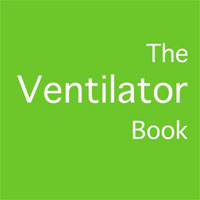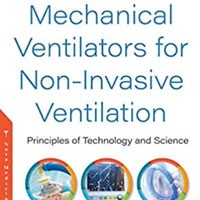Tag: mechanical ventilation
SOFA Score Accuracy For Determining Mortality Of Severely Ill Patients With COVID-19 Pneumonia
The SOFA score possesses inadequate discriminant accuracy to be used for ventilator triage of COVID-19 patients. A better option is needed that incorporates variables specifically related to mortality in patients with COVID-19... read more
Innovations in ICU Ventilation
Many centuries ago, Socrates stated that "the secret of change is to focus all of your energy, not on fighting the old, but on building the new." Nowadays, we may relate his quote with the concept of innovation, which is... read more
Epidemiology and microbiology of ventilator-associated pneumonia in COVID-19 patients
The COVID-19 pandemic is responsible for many hospitalizations in intensive care units (ICU), with widespread use of invasive mechanical ventilation (IMV) which exposes patients to the risk of ventilator-associated pneumonia... read more
Is chloroquine or hydroxychloroquine useful in treating people with COVID-19, or in preventing infection in people who have been exposed to the virus?
COVID-19 is an infectious respiratory disease caused by a coronavirus called SARS-CoV-2. If the infection becomes severe, people may need intensive care and support in hospital, including mechanical ventilation. Drugs... read more
Barotrauma in Mechanically-ventilated Patients with COVID-2019
Within the limits of a survey, patients with COVID-19 might be at high risk for barotrauma during invasive (and allegedly lung-protective) mechanical ventilation. The response rate was 38/61 (62%). The incidence of... read more
COVID-19 and VILI: Mechanical Power Measurement
The COVID-19 pandemic has increased the need for a bedside tool for lung mechanics assessment and ventilator-induced lung injury (VILI) monitoring. Mechanical power is a unifying concept including all the components which... read more
Nebulised heparin for patients with or at risk of ARDS
In patients with or at risk of acute respiratory distress syndrome (ARDS), nebulised heparin did not improve self-reported performance of daily physical activities, but was well tolerated and exploratory outcomes suggest... read more
Effectiveness of Bundle Interventions on ICU Delirium
This meta-analysis fails to support that bundle interventions are effective in reducing ICU delirium prevalence and duration, but supports that bundle interventions are effective in reducing the proportion of patient-days... read more
Colchicine, the only effective oral medication for treating non-hospitalized COVID-19 patients
The Montreal Heart Institute announced COLCORONA clinical trial has provided clinically persuasive results of colchicine's efficacy to treat COVID-19. The study results show that colchicine reduces the risk of death or... read more
De Novo Renal Failure and Clinical Outcomes of Patients With Critical COVID-19
This case series concludes that respiratory failure conveys significant mortality risk in patients with coronavirus disease 2019 and that survival with concomitant renal failure is rare. This is a case series of patients... read more
COVID-19 Pneumonia: Typical or Atypical Form of ARDS?
Evidence-based guidelines can never help a doctor resolve whether a patient is best managed by inserting an endotracheal tube or avoiding its use. That decision is based on clinical judgment, gestalt, and tacit knowledge.... read more
Delirium Prevalence and Risk Factors for Critically Ill COVID-19 Patients
Acute brain dysfunction was highly prevalent and prolonged in critically ill patients with COVID-19. Benzodiazepine use and lack of family visitation were identified as modifiable risk factors for delirium, and thus these... read more
Estimate Artery Occlusion Pressure in Critically Ill Patients Under Mechanical Ventilation Using Doppler Echocardiography
In mechanically ventilated critically ill patients, Doppler transthoracic echocardiography indices are highly specific but not sensitive to estimate pulmonary artery occlusion pressure. Transmitral early velocity wave... read more
Time-Controlled Adaptive Ventilation Versus Volume-Controlled Ventilation in Experimental Pneumonia
In the model of pneumonia used herein, at the same tidal volume and mean airway pressure, time-controlled adaptive ventilation, compared with volume-controlled ventilation, was associated with less lung damage and bacteremia... read more
The Ventilator Book
If you need something that teaches you both the concepts of mechanical ventilation and how to manage patients with respiratory failure, this is the book for you. The Ventilator Book is written to be read in the ICU or Emergency... read more

Outcomes Associated with the Use of Renin-Angiotensin-Aldosterone System Blockade in Hospitalized Patients with COVID-19 Infection
Use of ACEI or ARBs prior to hospitalization was not associated with adverse outcomes in COVID-19 and the therapeutic benefits of continuing ACEI or ARB in hospitalized patients with COVID-19 was not offset by adverse outcomes. Data... read more
Doppler Echocardiographic Indices in Critically Ill Patients Under Mechanical Ventilation
Doppler Echocardiographic Indices Are Specific But Not Sensitive to Predict Pulmonary Artery Occlusion Pressure in Critically Ill Patients Under Mechanical Ventilation. The objective of this study was to prospectively... read more
Weaning the patient: between protocols and physiology
Ventilator weaning forms an integral part in critical care medicine and strategies to shorten duration are rapidly evolving alongside our knowledge of the relevant physiological processes. The purpose of the current review... read more
Clinical characteristics of critically ill patients with COVID-19
In this study of critical patients infected by SARS-CoV-2 in a high-complexity hospital, the majority were comorbid elderly men, a large percentage required invasive mechanical ventilation, and ICU mortality was 25%. Design... read more
Development and assessment of the performance of a shared ventilatory system
Using standard clinical components, a system of shared ventilation consisting of two ventilatory limbs was assembled and connected to a single ventilator. Individual monitors for each circuit were developed using widely available... read more
What’s new about pulmonary hyperinflation in mechanically ventilated critical patients
Pulmonary hyperinflation is the increase in the relaxation volume of the respiratory system at the end of a tidal expiration (end-expiratory volume). This can occur due to a number of factors, acting alone or in combination,... read more
Mechanical Ventilators for Non-invasive Ventilation
This book analyzes and describes the whole spectrum of technical elements related with non-invasive mechanical ventilators technologies, ventilator modes and complementary technologies for correct interpretation and clinical... read more










